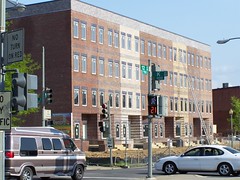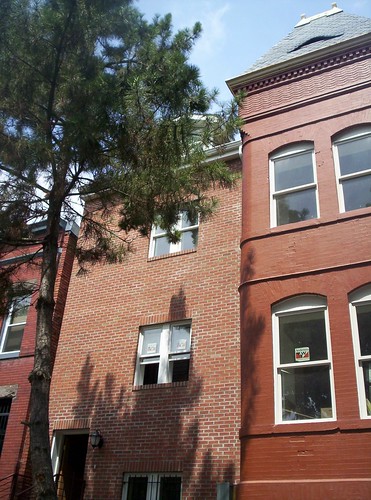Historic preservation and new construction
I am late in writing the follow up entry to "Historic Preservation," where the great comment thread made me remember something I forgot to include in the entry, a short discussion on the issue of new construction in historic districts.
This is an ongoing problem. The Secretary of the Interior's Standards for the Treatment of Historic Properties and The Secretary of the Interior's Standards for Rehabilitation don't specifically discuss the design of new construction within historic _districts_ so much, as the standards concern individual buildings.
But the point in the Rehabilitation Standards:
3. Each property shall be recognized as a physical record of its time, place, and use. Changes that create a false sense of historical development, such as adding conjectural features or architectural elements from other buildings, shall not be undertaken.
generally has been interpreted to mean that new construction in historic districts should be of the current time, rather than a copy of the old.
In the field, there is a debate about this, whether architecture should be "of its time" or "of its place." One of the reason that the "of its place" argument is so important is that you can see how the inclusion of new construction of different design tends to cheapen the whole of a district, certainly of its block, as it tends to be out of character and it shows.
My point about this has been you shouldn't hold fire, rioting, disinvestment etc. resulting in the loss of quality buildings, against the character of a neighborhood, that context sensitive new construction should fit in with the old, rather than be allowed to excuse new construction of dreck.

New construction on the 900 block of 12th Street NE (not in the Capitol Hill Historic District).
Of its place represents the position that the quality of the overall built form matters the most, when it comes to livability and maintaining the qualities that make neighborhoods great places. I've been fortunate to hear Steven Semes speak on this and he's also written about it, in "New Buildings Among Old: Historicism and the Search for an Architecture of Our Time."
Semes' paper lays out all the arguments for why the way these issues have been interpreted lead to the "decontextualization of historic buildings—they become museum artifacts instead of remaining part of our living world." His concludes that:
This growing dissent within the architectural and preservation communities represents the paradigm shift now in progress as the grip of historicist doctrine is gradually broken. In its place, a new conservation ethic is emerging, drawing together traditional architecture, new urbanism and historic preservation in pursuit of a built environment that is beautiful, sustainable and just. In the new paradigm, the architecture of our time will be the result of a critical engagement with the architecture of place, seen as a continuously self-renewing field of character and civility.
There are some good examples of new construction that fits in quite well, and other that doesn't, in Greater Capitol Hill, in the historic district there. If you're out, check out buildings at:
-- NE corner of 5th and East Capitol Streets NE
-- west side, 200 block of 7th Street NE
-- north side, 600 block of Maryland Avenue NE
for quality examples.
There are other examples that don't work well, such as the houses with way too many different colored courses of brick on the west side of the 500 block of 6th Street NE, and there are many places that have been allowed to have secondary quality materials (of brick or siding) on rears of buildings that are still visible from parts of the street.
This is a building not in the historic district, but in an area of equivalent building stock, on the 1300 block of Maryland Avenue NE. It's hard to get a good photo of the building, because of a tree in the front yard, but even this photo shows the significant difference in style, placement of windows, etc. It's pathetic really, and another example of why design review should be required everywhere, whether or not areas are designated as historic.




0 Comments:
Post a Comment
<< Home